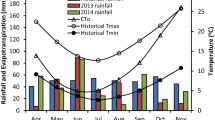Abstract
The albedo (α) of vegetated land surfaces is a key regulatory factor in atmospheric circulation and plays an important role in mechanistic accounting of many ecological processes. This paper examines the influence of the phenological stages of maize (Zea mays) and cowpea (Vigna unguiculata) fields on observed albedo at a tropical site in Ghana. The crops were studied for the first and second planting dates in the year 2002. Crop management was similar for both seasons and measurements were taken from 10 m×10-m plots within crop fields. Four phenological stages were distinguished: (1) emergence, (2) vegetative, (3) flowering, and (4) maturity. α measured from two reference surfaces, short grass and bare soil, were used to study the change over the growing seasons. Surface α was measured and simulated at sun angles of 15, 30, 45, 60, and 75°. Leaf area index (LAI) and crop height (CH) were also monitored. Generally, α increases from emergence to maturity for both planting dates in the maize field but slightly decreases after flowering in the cowpea field. For maize, the correlation coefficient (R) between α and LAI equals 0.970, and the R between α and CH equals 0.969. Similarly, for cowpea these Rs are 0.988 and 0.943, respectively. A modified albedo model adequately predicted the observed αs with an overall R>0.860. The relative difference in surface α with respect to the α values measured from the two reference surfaces is discussed. Data presented are expected to be a valuable input in agricultural water management, crop production models, eco-hydrological models and in the study of climate effects of agricultural production, and for the parameterization of land-surface schemes in regional weather and climate models.





Similar content being viewed by others
References
Adu SV, Mensah-Ansah JA (1995) Soils of the Afram basin: Ashanti and eastern regions, Ghana. (Memoir no. 12) Soil Research Institute, pp 17–53
Alatise MO (2002) Growth, yield and water use pattern of maize under limited water supply. PhD dissertation. Federal University of Technology, Akure
Ben-Gai T, Bitan A, Manes A, Albert P, Israeli A (1998) Aircraft measurements of surface albedo in relation to climatic changes in southern Israel. Theor Appl Climatol 61:207–215
Cuf AD, Fisch G, Hodnett MG (1995) The albedo of Amazonian forest and rangeland. J Clim 8:1544–1554
Dickson KB, Benneh G (1995) A new geography of Ghana. Longman, Malaysia
Giambelluca TW, Fox J, Yarnasarn S, Onibutr P, Nullet MA (1999) Dry season radiation balance of land covers replacing forest in northern Thailand. Agric For Meteorol 95:53–63
Idso SB, Jackson RD, Reginato RJ, Kimbal BA, Nakayama FS (1975) The dependence of bare soil albedo on soil water content. J Appl Meteorol 14:109–113
Iziomon MG, Mayer H (2002) On the variability and modelling of surface albedo and long-wave radiation components. Agric For Meteorol 111:141–152
Jacobs AFG, van Pul WAJ (1990) Seasonal changes in the albedo of a maize crop during two seasons. Agric For Meteorol 49:351–360
Jensen JR, Rahman MdM (1987) A semi-empirical model for calculating evaporation and transpiration from wetland rice. Agric For Meteorol 41:289–306
Linacre E (1992) Climate data and resources, a reference and a guide. Routledge, New York
Lobell DB, Asner GP (2002) Moisture effects on soil reflectance. Soil Sci Soc Am J 66:722–727
Matthias AD, Fimbres A, Sano EE, Post DF, Accioly L, Batchily AK, Ferreira LG (2000) Surface roughness effects on soil albedo. Soil Sci Soc Am J 64:1035–1041
McCaughey JH (1987) The albedo of a mature mixed forest and a clear-cut site at Petawawa, Ontario. Agric For Meteorol 40:251–263
Minnis P, Mayor S, Smith WL, Young DF (1997) Asymmetry in the diurnal variation surface albedo. IEEE Trans Geosci Remote Sensing 35:879–891
Monteith JL, Unsworth MH (1990) Principles of environmental physics. Arnold, New York
Pinker RT, Thompson OE, Eck TF (1980) The albedo of a tropical evergreen forest. QJR Meteorol Soc 106:551–558
Ross J (1975) Radiative transfer in plant communities. In: Monteith JL (ed) Vegetation and the atmosphere, vol 1. Principles. Academic Press, London, pp 13–55
San Jose JJ, Bracho R, Montes R, Nikonova N (2003) Comparative energy exchange from cowpeas (Vigna unguiculata(L.) walpcvs. TC-9-6 and M-28-6-6) with differences in canopy architectures and growth durations at the Orinoco llanos. Agric For Meteorol 116:197–219
Sellers PJ, Randall DA, Collatz GJ, Berr JA, Field CB, Dazlich DA, Zhang C, Collelo GD, Bounoua L (1996) A revised land surface parameterization (SIB2) for atmospheric GCMs. Part I. Model formulation. J Clim 9:676–705
Song J (1998) Diurnal asymmetry in surface albedo. Agric For Meteorol 92:181–189
Song J (1999) Phenological influences on the albedo of prairie grassland and crop fields. Int J Biometeorol 42:153–157
Standhill G (1970) Some results of helicopter measurements of the albedo of different land surfaces. Solar Energy 13:59–66
Tooming H (2002) Dependence of global radiation on cloudiness and surface albedo in Tatu, Estonia. Theor Appl Climatol 72:165–172
Uchijima Z (1976) Maize and rice. In: Monteith JL (ed) Vegetation and the atmosphere, vol 2. Principles. Academic Press, London, pp 33–64
Yin X (1998) The albedo of vegetated land surfaces: systems analysis and mathematical modelling. Theor Appl Climatol 60:121–140
Acknowledgements
Grant no. 07GWK01 (for the GLOWA Volta project) provided by the German Federal Ministry of Education and Research, with additional support from the State of North Rhine Westphalia, supported this study. The first author also thanks the German Academic Exchange Service (DAAD) for a scholarship award.
Author information
Authors and Affiliations
Corresponding author
Rights and permissions
About this article
Cite this article
Oguntunde, P.G., van de Giesen, N. Crop growth and development effects on surface albedo for maize and cowpea fields in Ghana, West Africa. Int J Biometeorol 49, 106–112 (2004). https://doi.org/10.1007/s00484-004-0216-4
Received:
Revised:
Accepted:
Published:
Issue Date:
DOI: https://doi.org/10.1007/s00484-004-0216-4




